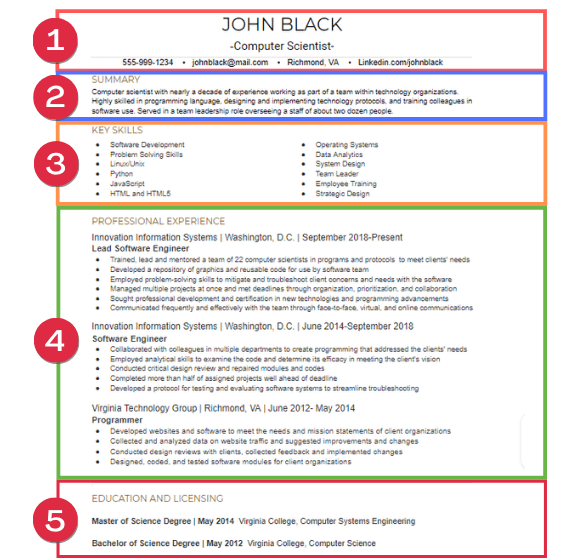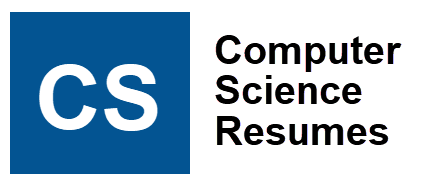Computer Science Resume Sample
When you apply for a position in the field of computer science, you will want your resume to highlight your collective work history and preparation for the job. It is important that the potential employer is able to see you as a highly motivated, experienced, and skilled employee who can bring expertise and vision to the team. Here are some tips for crafting the most effective resume for a computer science job.
Things to Keep in Mind When Writing Your Computer Science Resume
A strong resume is the first step to landing a coveted interview for your dream job. Many employers use computer programs to screen resumes for target information that is relevant to the position. As you work on compiling your resume, you will want to make sure it meets the following criteria:
Succinct and Organized: Although you will be tempted to share all of your skills and experiences, aim to keep the length of the resume to one page, but no more than 2. Select the most relevant information to the position for which you are applying.
Detailed: While it may seem incongruous with the first criterion, detail is important, especially in your work experiences. Be sure to choose your language carefully, looking to the key words in the job posting to guide you on what to highlight.
Engaging: Although the cover letter is the place to really sell yourself and your passion, you want your resume to paint a picture of your strengths and benefits to the company. Use action language to better illustrate your accomplishments.
Readable: It may be tempting to experiment with the appearance of your resume to make it stand out, but employers prefer standard fonts and sizes. Bullets help to organize information and subheadings make it easier to scan for information.
Keep in mind that your resume is the employer's initial introduction to your skills, experiences, and the way that you communicate in a professional setting. Here are specific guidelines regarding what to include in each section in order to make the best first impression.

Section 1: Your Contact Information
Personal information should be featured at the very top of the resume. This section should include your name, street address, phone number, and email. If you have a professional social media account or website that features examples of your work, you may also want to include a

link. Always make sure that any email address, website, or social media that you include are appropriate and professional.
Section 2: The Summary
Below your contact information, you will want to include a brief statement that offers the reader a summary of your years of experience, your interests, and your most relevant strengths and skills. It is important to clearly align your information in this section with the mission statement or vision of the company to which you are applying. The summary section is typically 2-4 sentences in length.

When creating your summary statement, keep in mind that it is an overview and does not need to include the breadth of your specific skills and experiences. The following sections of your resume will give you the space to describe these more in detail.
Section 3: Core Competencies
In this section, you should use a bulleted list to outline between 12 and 15 skills that are relevant to the position to which you are applying. Do not write complete sentences in this section; describe the skills as succinctly as possible so that the section is easy to skim and understand. Keep in mind that your application of the skills can be further expounded upon in the work experience section.

Since jobs vary so widely in the field of computer science, be sure to tailor this section to the most relevant skills and qualifications required for the specific position. Use the job posting to inform the language that you use and the skills that you choose to highlight.
Section 4: Professional Experience
The next and largest section of your resume will be your professional work experience. The list of your previous positions should begin with the most recent and work backwards in descending chronological order. Each position should be outlined in the same format in order to make it uniform and easy to read. Begin by listing the name of the company, their location including city and state, followed by the dates that you worked there, with both the month and year.
The next line provides you with a space to explain your job title in a few words. For example, writing "Computer Support Technician" will give the reader context about your position and the potential expectations and responsibilities that accompanied that job.

The next and largest section of your resume will be your professional work experience. The list of your previous positions should begin with the most recent and work backwards in descending chronological order. Each position should be outlined in the same format in order to make it uniform and easy to read. Begin by listing the name of the company, their location including city and state, followed by the dates that you worked there, with both the month and year.
The next line provides you with a space to explain your job title in a few words. For example, writing "Computer Support Technician" will give the reader context about your position and the potential expectations and responsibilities that accompanied that job.
Following your job title, you should include a bulleted list of your skills and accomplishments within your role and time at the company. Be specific and make sure to highlight your greatest strengths and achievements. Use verbs to emphasize your active role in your position. For example:
Trained employees in using and troubleshooting the network, software, and email systems
Designed and implemented a software system that increased employee efficiency
Collaborated with client to develop a secure network that mitigated and decreased breaches
Although you likely have significant experience and accomplishments in each of your previous jobs, do not create an exhaustive list. Focus on the skills and responsibilities that best address the prospective position. If you are newer to the field and do not have as much experience to draw on, include any internship experiences or collaborative work that you engaged in with more senior or experienced computer scientists.
Section 5: Education and Licensure
The final section of your resume provides a place to list your educational experience. Similar to the work experience section, you should begin by listing the most recent university that you attended. Include the degree that you attained, your major, the college, and year of graduation.

Depending on the position for which you are applying, you may require at least a Bachelor's or Master's degree. Even if the job does not require an advanced degree, list any and all that you have completed, as this could increase the appeal of your background to the employer.
Putting It All Together
When you have finished compiling your resume, be sure to proofread it. Correct any formatting, spelling, or grammatical errors. Once you have looked it over, have a trusted friend or colleague review it as well. Their fresh perspective can provide feedback on how the resume reads to a potential employer and to suggest tweaks that you may not catch on your own.

To help guide your final review, ask yourself these questions:
- Did you use strong, action-based language throughout?
- Were you consistent with the tense?
- Did you use proper grammar from top to bottom?
- Are there area where you could cut out words to make things simpler and easier to understand?
- What bullet points still include unquantified activity? Can you add some numbers to those?
Finally, the BIG question... does your computer science resume tell your story, clearly and concisely?
If the answer is an unqualified "Yes!" then you should be good to go.
If not, then perhaps now would be a good time to reach out for some professional help.
